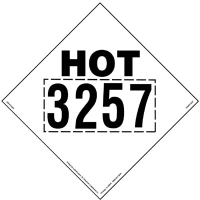Defined at 49 CFR 171.8, “Elevated Temperature Material means a material which, when offered for transportation or transported in a bulk packaging:
- Is in a liquid phase and at a temperature at or above 100 °C (212 °F);
- Is in a liquid phase with a flash point at or above 38 °C (100 °F) that is intentionally heated and offered for transportation or transported at or above its flash point;or,
- Is in a solid phase and at a temperature at or above 240 °C (464 °F).”
Note that in addition to meeting one of the three conditions listed it also must be “offered for transportation or transported in a bulk packaging…” in order to be defined as an Elevated Temperature Material. That means, the same material transported in a non-bulk packaging can not be an Elevated Temperature Material.
Understanding what is, and isn’t, an Elevated Temperature Material is important since it is specifically included in the definition of a Hazardous Material, also at 49 CFR 171.8, “Hazardous material means a substance or material that the Secretary of Transportation has determined is capable of posing an unreasonable risk to health, safety, and property when transported in commerce, and has designated as hazardous under section 5103 of Federal hazardous materials transportation law (49 U.S.C. 5103). The term includes hazardous substances, hazardous wastes, marine pollutants, Elevated Temperature Materials, materials designated as hazardous in the Hazardous Materials Table (see 49 CFR 172.101), and materials that meet the defining criteria for hazard classes and divisions in part 173 of subchapter C of this chapter.”
An Elevated Temperature Material may be a hazardous material solely because it matches the definition in §171.8 or it may possess additional hazards (flammable, corrosive, reactive, etc.). Either way, you must choose a proper shipping name from the Hazardous Materials Table and follow the requirements of the Hazardous Material Regulations.
On the shipping paper, the word “HOT” must immediately proceed the proper shipping name unless “elevated temperature” or “molten” is already included in the proper shipping name [49 CFR 172.203(n)]. However, you may include the word “HOT” on the shipping paper, even if not required, as additional information.
While there is no “HOT” label or placard, you must ensure that the bulk packaging containing your Elevated Temperature Material is labeled and placarded pursuant to 49 CFR 172, Subpart F applicable to its hazard class (Flammable, Class 9, or other). The labeling and placarding requirements for bulk packagings can be complicated, but in general:
- A bulk packaging of ≥1,000 gallons capacity must be placarded and marked with the identification number on all four sides.
- A bulk packaging of <1,000 gallons capacity may be placarded or labeled on two opposing sides and may be marked with the identification number on two opposing sides.
Like this article? Subscribe to my Monthly Newsletter No marketing emails! |
There are, however, marking requirements specific to Elevated Temperature Materials found at 49 CFR 172.325, they include:
- A bulk packaging containing an Elevated Temperature Material must display the “HOT” marking on two opposing sides. This marking, while not a placard, must meet the specific requirements of §172.325(a) and have the “same outside dimensions as a placard”.
- A bulk packaging of an Elevated Temperature Material that is molten aluminum or molten sulfur must be marked “MOLTEN ALUMINIUM” or “MOLTEN SULFUR” in the same manner as described in §172.325(a).
- If the identification number marking is displayed on a white-square-on-point display configuration [§172.336(b)], the word “HOT” may be displayed in the upper corner of the display. If you use this option, you must comply with the requirements of §172.325(c).
You should also check 49 CFR 173.427 which contains additional requirements for bulk packagings of certain Elevated Temperature Materials.
If you offer for shipment an Elevated Temperature Material, then you are a shipper of hazardous materials. Any of your employees involved in the transportation of hazardous materials must receive triennial HazMat Employee Training. Contact me to determine your training requirements and how best to meet them.
Daniels Training Services 815.821.1550 |

